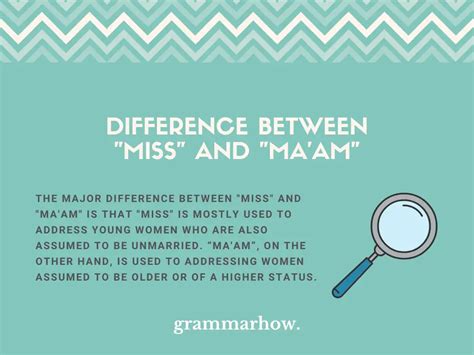Introduction
In the tapestry of social interactions, the words we choose to address others play a crucial role in conveying respect and courtesy. When addressing women, the choice between “Miss” and “Ma’am” can sometimes evoke confusion or uncertainty. This comprehensive guide delves into the nuances of these terms, exploring their origins, proper usage, and the subtle yet profound impact they have on the recipient.

Historical Context
The term “Miss” originated in the 15th century and initially denoted an unmarried woman of any age. It was later used exclusively for young, unmarried women, while “Ma’am” (short for “Madam”) became the respectful form of address for married women.
Age Distinction
In the United States, the traditional usage of “Miss” and “Ma’am” is based on marital status. Typically:
- Miss: Used for unmarried women of any age.
- Ma’am: Used for married women and unmarried women over the age of 18-21, depending on regional norms.
Marital Status and Social Context
While marital status traditionally determined the choice between “Miss” and “Ma’am,” societal norms have evolved over the years:
- In professional settings, “Ma’am” is often used as a respectful form of address for all women, regardless of marital status.
- In casual situations, women may prefer “Miss” or “Ma’am” based on personal preference or the context of the interaction.
Tone and Respect
Beyond marital status, the tone and context of the interaction play a significant role in choosing between “Miss” and “Ma’am”:
- “Miss” conveys a more formal or professional tone, while “Ma’am” implies warmth and familiarity.
- In customer service or hospitality settings, “Ma’am” is often used to show respect and deference to women of all ages.
Common Mistakes to Avoid
To maintain politeness and avoid any discomfort or miscommunication:
- Never use “Miss” or “Ma’am” with a woman’s first name.
- Do not shorten “Ma’am” to “Mam.”
- If you are unsure about the appropriate term to use, it is always safer to err on the side of formality and use “Ma’am.”
Benefits of Respectful Address
Addressing women respectfully using the correct terms conveys several benefits:
- Creates a positive and respectful atmosphere.
- Shows consideration and appreciation for the recipient.
- Avoids awkwardness or offense.
- Builds trust and rapport in professional relationships.
Table 1: Traditional Usage of “Miss” and “Ma’am”
| Miss | Ma’am | |
|---|---|---|
| Marital Status | Unmarried | Married, or unmarried and over 18-21 |
| Age | Any age | Typically over 18-21 |
Table 2: Evolving Usage in Professional Settings
| Setting | Miss | Ma’am |
|---|---|---|
| Business Meetings | Yes | More common |
| Customer Service | No | Yes |
| Healthcare | No | Yes |
| Education | No | Yes |
Table 3: Polite Address in Different Languages
| Language | Miss | Ma’am |
|---|---|---|
| Spanish | Señorita | Señora |
| French | Mademoiselle | Madame |
| Mandarin | Xiǎojiě | Nǚshì |
Table 4: Respectful Variations
| Variation | Context |
|---|---|
| Ms. | Formal, unmarried or married |
| Mrs. | Formal, married |
| Mx. | Gender-neutral, inclusive |
Step-by-Step Approach to Addressing Women Respectfully
- Observe the woman’s appearance and context.
- If you are unsure about her marital status, use “Ma’am.”
- If you know her marital status, use “Miss” for unmarried women and “Ma’am” for married women.
- Use the appropriate tone for the setting and relationship.
- Avoid using first names or nicknames with “Miss” or “Ma’am.”
Conclusion
The choice between “Miss” and “Ma’am” requires consideration of various factors, including marital status, age, social context, and tone. By adhering to the guidelines outlined in this comprehensive guide, you can address women with respect and courtesy, creating a positive and respectful atmosphere in all interactions. Remember, the correct usage of these terms is not merely a matter of etiquette but a reflection of our values as a society. So, the next time you encounter a woman, take a moment to choose the appropriate term and show her the respect she deserves.
